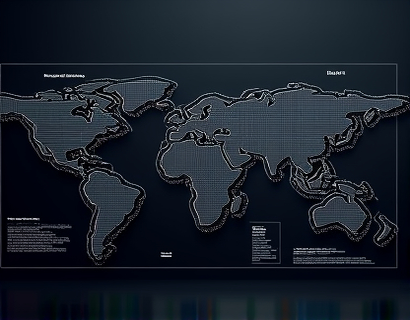Unlocking Complex Insights: Cutting-Edge Software for Advanced Graph Theory and Fluid Dynamics Research
In the realm of scientific research, the intersection of graph theory and fluid dynamics presents some of the most intricate challenges and opportunities for innovation. Advanced software tools have emerged to address these complexities, offering researchers and engineers unprecedented capabilities to analyze, visualize, and model intricate systems. This article delves into the cutting-edge software designed specifically for graph theory and fluid dynamics research, highlighting how these tools can streamline data analysis, enhance visualization, and drive groundbreaking discoveries.
Advanced Graph Theory Software
Graph theory, a branch of mathematics that studies the properties and applications of graphs, has found extensive applications in various fields, including computer science, network analysis, and optimization. For researchers delving into graph theory, the complexity of data often hampers the ability to extract meaningful insights. Modern software solutions have been developed to tackle these challenges, providing robust tools for graph manipulation, analysis, and visualization.
One of the key features of advanced graph theory software is its ability to handle large and complex networks efficiently. These tools employ sophisticated algorithms to perform tasks such as shortest path calculations, network flow analysis, and community detection. By leveraging parallel processing and optimized data structures, these software solutions can process vast amounts of data in a fraction of the time required by traditional methods.
Visualization is another critical aspect of graph theory research. Complex networks are often difficult to comprehend in their raw form. Advanced software provides interactive and dynamic visualization capabilities, allowing researchers to explore and understand the structure and behavior of graphs intuitively. Features such as node and edge coloring, layout algorithms, and zooming capabilities make it easier to identify patterns, anomalies, and relationships within the data.
Enhanced Fluid Dynamics Software
Fluid dynamics, the study of fluids in motion, is essential for understanding a wide range of phenomena, from weather patterns to the flow of liquids in industrial processes. The mathematical modeling of fluid dynamics is notoriously complex, involving partial differential equations and numerical methods. Cutting-edge software for fluid dynamics research offers powerful tools to tackle these challenges, enabling precise analysis and simulation of fluid behavior.
One of the primary functions of advanced fluid dynamics software is the simulation of fluid flow and heat transfer. These simulations are based on the Navier-Stokes equations, which describe the motion of fluid substances. High-fidelity solvers and adaptive mesh refinement techniques allow for accurate and efficient simulations, even in highly turbulent or multiphase flow scenarios. Researchers can simulate a wide range of conditions, from laminar to turbulent flows, and study the effects of various parameters on fluid behavior.
Visualization plays a crucial role in fluid dynamics research as well. Advanced software provides sophisticated visualization tools that transform complex simulation data into intuitive and informative visual representations. Features such as vector fields, streamlines, and isosurfaces help researchers visualize flow patterns, pressure distributions, and other critical parameters. These visualizations are essential for identifying trends, validating models, and communicating results to both technical and non-technical audiences.
Integration of Graph Theory and Fluid Dynamics
The integration of graph theory and fluid dynamics research opens up new avenues for innovation. For instance, graph-based methods can be used to discretize fluid domains, simplifying the computational complexity of fluid dynamics simulations. Conversely, fluid dynamics simulations can provide valuable data for graph theory analyses, such as network topology and connectivity studies. This synergy between the two fields can lead to more comprehensive and accurate models of complex systems.
Advanced software solutions facilitate this integration by providing a unified platform for both graph theory and fluid dynamics research. These tools allow researchers to seamlessly switch between different modeling approaches, leveraging the strengths of each field to solve multifaceted problems. For example, a researcher might use graph theory to model the connectivity of a porous medium and then employ fluid dynamics simulations to study fluid flow through the medium.
Optimizing Performance in Complex Systems
Complex systems, whether they involve intricate networks or fluid flows, require precise and efficient analysis to optimize performance. Advanced software for graph theory and fluid dynamics research offers a range of features to help researchers achieve this goal. One such feature is the ability to perform parametric studies, where researchers can systematically vary parameters to understand their impact on system behavior. This is particularly useful in fluid dynamics, where factors such as velocity, pressure, and viscosity can significantly influence flow patterns.
Another important aspect is the optimization of computational resources. Advanced software often includes parallel computing capabilities, allowing researchers to distribute tasks across multiple processors or even clusters of computers. This not only speeds up computations but also enables the handling of larger and more complex datasets. Efficient memory management and optimized algorithms further enhance the performance of these tools, making them suitable for high-performance computing environments.
Enhanced Data Analysis and Insight Generation
Data analysis is at the core of both graph theory and fluid dynamics research. Advanced software provides powerful analytical tools to extract meaningful insights from raw data. For graph theory, this includes algorithms for centrality measures, clustering, and motif detection, which help identify key nodes and structures within a network. For fluid dynamics, advanced solvers and post-processing tools enable the extraction of critical flow features, such as vortices, shear layers, and boundary layers.
Machine learning and artificial intelligence techniques are increasingly being integrated into these software tools. By applying machine learning algorithms to large datasets, researchers can discover hidden patterns and correlations that might not be apparent through traditional analysis methods. For example, machine learning can be used to predict fluid flow behavior based on historical data or to classify different types of network topologies.
User-Friendly Interfaces and Collaboration Tools
To ensure that advanced software is accessible to a wide range of users, modern tools are designed with user-friendly interfaces. Graphical user interfaces (GUIs) provide intuitive controls and visual feedback, making it easier for researchers and engineers to navigate complex functionalities. Interactive tutorials and documentation further support users in mastering the software.
Collaboration is another critical aspect of modern research. Advanced software often includes features that facilitate collaboration among team members, such as cloud-based storage, version control, and real-time sharing of results. These features enable researchers to work together seamlessly, regardless of their physical location, fostering a more collaborative and efficient research environment.
Case Studies and Real-World Applications
To illustrate the practical impact of advanced graph theory and fluid dynamics software, consider a few real-world applications. In the field of transportation, graph theory software has been used to optimize traffic flow and public transit systems, reducing congestion and improving efficiency. For instance, researchers have employed graph algorithms to design more efficient routing strategies for urban buses and trains.
In the realm of environmental science, fluid dynamics software has been instrumental in studying ocean currents and atmospheric flows. These simulations help predict weather patterns and understand the impacts of climate change. For example, researchers have used fluid dynamics models to simulate the effects of melting ice caps on ocean circulation, providing valuable insights for climate models.
In the industrial sector, these tools have found applications in the design and optimization of pipelines, heat exchangers, and other fluid-handling systems. By simulating fluid flow and heat transfer, engineers can identify bottlenecks, optimize performance, and reduce energy consumption. This not only leads to cost savings but also contributes to more sustainable practices.
Future Directions and Emerging Trends
The field of graph theory and fluid dynamics research is continually evolving, with new challenges and opportunities on the horizon. One emerging trend is the integration of multi-scale modeling, which combines different levels of resolution to capture both macroscopic and microscopic behaviors. This approach is particularly relevant in complex systems where phenomena occur at multiple scales, such as in biological networks or multiphase flows.
Another area of growth is the use of quantum computing to solve problems that are currently intractable with classical computers. Quantum algorithms have the potential to revolutionize both graph theory and fluid dynamics by providing exponential speedups for certain computations. While still in the early stages, research in this area holds promise for future breakthroughs.
Furthermore, the increasing availability of big data and the Internet of Things (IoT) is generating vast amounts of real-time data that can be leveraged for more accurate and dynamic modeling. Advanced software will need to adapt to handle these data streams efficiently, providing real-time insights and adaptive simulations.










































